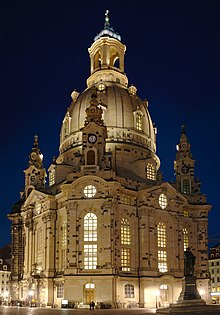
Reconstruction in architectural conservation is the returning of a place to a known earlier state by the introduction of new materials.[1] It is related to the architectural concepts of restoration (repairing existing building fabric) and preservation (the prevention of further decay), wherein the most extensive form of reconstruction is creating a replica of a destroyed building.
More narrowly, such as under the Secretary of Interior's Standards in the United States, "reconstruction" is "the act or process of depicting, by means of new construction, the form, features, and detailing of a non-surviving site, landscape, building, structure, or object for the purpose of replicating its appearance at a specific period of time and in its historic location".[2]

There may be several reasons for the construction of a building or creation of a replica building or structure.
Sometimes, it is the result of destruction of landmark monuments that is experienced as traumatic by inhabitants of the region, such as through war, planning errors and politically motivated destruction, other times, merely the result of natural disaster. Examples include Yongdingmen (former Peking city gate temporarily sacrificed to traffic considerations), St Mark's Campanile in Venice (collapsed in 1902), House of the Blackheads (Riga), Iberian Gate and Chapel and the Cathedral of Christ the Saviour in Moscow (destroyed by order of Joseph Stalin), Dresden Frauenkirche and Semperoper in Dresden (bombed at the end of World War II). A specifically well-known example is the rebuilding of the historic city center of Warsaw after 1945. The Old Town and the Royal Castle had been badly damaged already at the outset of World War II. It was systematically razed to the ground by German troops after the Warsaw Uprising of 1944. The reconstruction of Warsaw's historic center (e.g., St. John's Cathedral, St. Kazimierz Church, Ujazdów Castle) and, e.g., the replica of the Stari Most built in Mostar (Bosnia Herzegovina) have met with official approval by UNESCO.
Other times, reconstructions are made in the case of sites where the historic and cultural significance was not recognized until long after its destruction, common in North America, especially with respect to its early history. Examples include the reconstruction of Colonial Williamsburg in Virginia, the rebuilding of numerous structures in Independence National Historical Park in Philadelphia, and Fort William Historical Park in Ontario, Canada.


There are different approaches to reconstruction, which differ in the degree of fidelity to the original and in the sensitivity to implementation. In architecture, Georg Mörsch describes reconstruction as a "scientific method of extracting sources to rebuild things that have gone under, regardless of the time that has passed since then".[4]
Regardless of what type of reconstruction is done, there are some recurring challenges and questions.

Since the end of the Second World War, the reconstruction of buildings has been the subject of controversy, especially in cities destroyed by the war.
In the public debate around reconstruction it is mostly assumed that historical or historicising architecture is perceived by the average citizen as more appealing than contemporary architecture. The loss of the "beautiful old" is seen as an aesthetic diminution, historically created and poorly closed building gaps are experienced as a permanent "flaw in the cityscape".[6]
The reconstruction of buildings is often controversial among architects and preservationists . There are different motives and values. Overall, the question of the reconstruction of prominent urban locations in the context of the cityscape proves to be significantly more conflict-prone than is the case with remote buildings or in the open, for example with experimental or didactic reconstructions.
Many reconstructions are new buildings with a historical façade design, but modern construction technology and with completely new uses. The original building fabric is often hardly preserved and architects in particular argue against this approach, saying that it merely creates a historical impression in order to appeal to a certain groups of buyers.[7]
However, there are also prominent examples of reconstructions with missing original substance. The reconstruction of completely destroyed Warsaw's Old Town is a reconstruction even in the UNESCO list of World Heritage. Reconstructed buildings are generally not perceived as such by those who are unfamiliar with them, which makes the cityscape more attractive in the eyes of the beholder. Even in the awareness of the residents, the fact of the reconstruction of a building is mostly forgotten after a while, the buildings are perceived again as an organic part of their environment. The desire for the original substance, which is usually put forward by monument conservationists, cannot be met in many old buildings either; one speaks of the Theseus paradox .
A crucial question in monument protection today is that of whether the value and originality is in the materials, or in the design. This does not only refer to the material erected at the time of construction, but also to the various later layers that are evidence of their times. The practice of both architectural and art history does not regard a certain version of an object as "the original", neither the first version nor the most splendid or most popular at the time, nor the last one that has been remembered.
The Venice Charter of 1964 was an international guideline for dealing with the original building fabric for the preservation of monuments; it is the most important monument conservation text of the 20th century and defines central values and procedures for the conservation and restoration of monuments .
Opponents of reconstruction often point out that rebuilding could contribute to the transfiguration of the past. Reconstruction critics from the architectural profession and related professions assume that modern urban design and contemporary architecture are an expression of social identity that is continuously developing. According to this, it is important for a society to maintain its architecture, which meets its living conditions and needs and whose expression it is, through building projects, and not, on the other hand, to recreate old architecture. This consensus on what is contemporary is questioned by those in favor of reconstruction. From cultural and historical Critics see reconstruction as a phenomenon of the 19th and 20th centuries that had hardly any role models in history and is now outdated. Reconstruction can thus only be historically legitimized to a limited extent. On the other hand, the term cityscape - as an architectural unit extending beyond the individual building - only came into the field of vision of architecture in the course of modernity. Proponents of the reconstruction, on the other hand, have little fear of contact with the harmonistic architectural conceptions of the 19th century and also point to the lasting popularity of the domes that were "then completed" according to the principles that are not permitted today. However, it is precisely the free access to the formal language of all earlier epochs that is considered one of the essential features of historicism as seen in postmodernism . In a different sense, the reconstruction fulfils the demand for an answer to the needs of the time and in this sense is an expression of contemporary building activity. How later historical epochs will judge the contemporary phase of architecture and its peculiarities cannot be said.
For architects it is often not desirable to create replicas instead of creating something new. In this sense, every new building is "more historically accurate" because the destroyed objects were an expression of their own time. On the one hand, the "idea of a building" is the actual work of an architect and a reconstruction would represent an appreciation in this sense. On the other hand, every architect works in some way with the history of the building site. This reference to the previous buildings is to be seen as an appreciation, even if it is in explicit contrast. Building solutions by the architects of the historical compete with a new project. The fundamental question that remains is why something should be created again instead of a new building.
Prominent individual examples of reconstruction projects and executions show that architecture is a factor in the public that can still polarize just as much as that from the history of architecture known all time. From a global perspective, the entire discussion about the pros and cons of reconstruction is a problem rooted in Eurocentric sensitivities. Other cultures, both the Anglo-American region and Asia, deal with the topic differently: The regular, complete rebuilding of a Buddhist temple is part of the centuries-old tradition in Asian architecture, the European concept of "true to the original" plays in this culture, which has everything in the philosophical core Material regarded as worthless shell, until today a subordinate role. The 2000 year old Ise-jingū-Shrines in Japan are ritually rebuilt every 20 years according to exactly the same plans made of wood. In China, for example, while entire historic cities and city centers are being sacrificed to major urban and economic planning projects ( Shanghai , 3 Gorges Dam ), conversely, historicizing projects are also being implemented - such as the old town project of Datong, a city in the Ming style, or the restoration of the one in the cultural revolution destroyed sacred buildings. In the USA, too, the monument concept plays only a subordinate role today and relates much more to historic monuments that are significant in terms of time and culture than to those of architectural history.
In a representative survey by the Forsa Institute on behalf of the German Federal Building Culture Foundation , 80% of all participants were in favor of the reconstruction of historic buildings and 15% were against. The approval of reconstructions was particularly high among women (83%) and 18 to 29 year olds (86%). When asked whether historical buildings should also be rebuilt for other uses, 80% of all participants answered with "yes" and 16% with "no".[8]
Prominent examples with worldwide attention that illuminate the diversity of reconstructive intentions and methods:

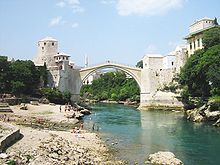

|
See also: Category:Rebuilt buildings and structures in Canada |


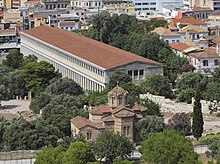
|
See also: Category:Rebuilt buildings and structures in India |
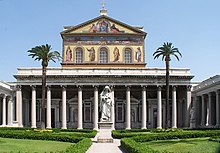

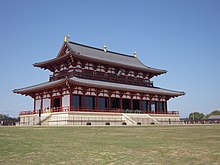

Plans are also being made for reconstructing the Birgu Clock Tower, which was destroyed in 1942.[14]
|
See also: Category:Rebuilt buildings and structures in Poland |
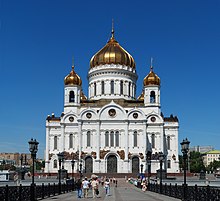
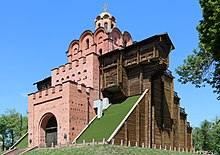
|
See also: Category:Rebuilt buildings and structures in the United Kingdom |

|
See also: Category:Rebuilt buildings and structures in the United States |